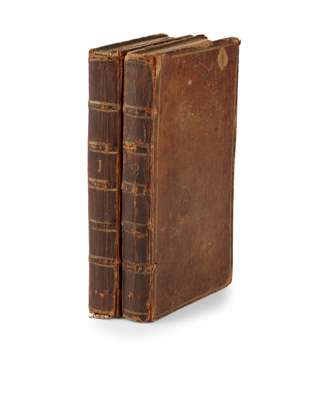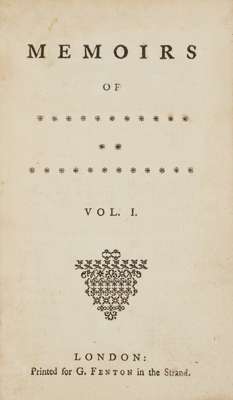
Lot 167
![[Cleland, John]](https://media.app.artisio.co/media/104cbde6-0d38-43cb-9e0f-bb721ef57bcf/inventory/d78cc3bf-9aeb-498c-8051-baceb57f6596/4f6ec315-28b8-4ded-8207-994a2de1de4e/0001_YHVeXx_original.jpg)
[Cleland, John]
Memoirs of *********** ** ************ [a Woman of Pleasure]






Rare Books, Manuscripts, Maps & Photographs
Auction: 13 July 2022 from 10:00 BST
Description
London: printed for G. Fenton in the Strand, [?1755], 2 volumes, 12mo, 232pp. + 252pp., typographic ornament on title-pages, contemporary calf, gilt rule to boards, volume number gilt stamped to spines, ownership inscription 'M.F. Heise, 1785' on front free endpapers, the free endpapers also with small unobtrusive blindstamp of a ?princely coronet with initials 'W.W.', slightly rubbed, joints split or partly split, occasional light spotting, [ESTC T84804: BL copy only]; with a single contemporary manuscript annotation 'Navarino' in lower margin of page 191 volume 1 referencing the word 'untoward' which is underlined
Provenance
Provenance: descendant of M.F. Heise, whose inscription appears on front free endpapers.
Footnote
Note: A very early edition of the first and the most famous erotic or pornographic novel in English.
'The novel, consisting of two letters addressed by the fictional character Frances “Fanny” Hill to a “Madam,” recounts in vivid and explicit detail Fanny’s transgressive sexual experiences from her adolescence through her middle age' (University of Indiana, 'Banned Books', online). The novel was perhaps the most heavily challenged book in court, in both England and the United States. It was first published unabridged in the United States by Putnam in 1963, but it was not until the landmark decision of the U.S. Supreme Court in Memoirs v. Massachussets (383 U.S. 413) in March 1966, that the ban imposed by the Attorney General of Massachusetts was lifted.
Cleland [1710-1789] composed his novel while serving a sentence for debt in the Fleet Prison. According to his own testimony, it was written largely from boredom and, the early chapters anyway, was based on an idea '... originally give me by a young gentleman of the greatest hopes I ever knew, above eighteen years ago, on an occasion immaterial to mention here'. Volume one appeared about November 1748, and volume two was published in early February the following year. Both were printed by Thomas Parker for Ralph Griffiths and advertised in the press at three shillings each volume.
'In November 1749, a warrant was issued for the arrest of the author, publisher and printer of the book and by the end of the month, Cleland, Griffiths and Parker... were all on bail and awaiting trial' (Kearney, A History of Erotic Literature, p.66). The bookseller and publisher Ralph Griffiths blamed everything on his brother, Fenton Griffiths, whose inverted name, G. Fenton, was used for the book's false imprint. When examined before Lord Stanhope, the Law Clerk in the Secretary of State's office on 13 November 1749 Ralph Griffiths said he had sold about 60 sets of the said work. Cleland in his defence argued ingeniously that had he not been prosecuted the work would have died a quiet death and added, somewhat maliciously, that the clergy were amongst the keenest buyers of the work. Cleland and his associates were found guilty in court, and the novel was withdrawn, at least officially, from circulation. Despite losing the case, however, Cleland seems to have escaped lightly; no record of any punishment exists.
Foxon states: 'There were four editions in which the title-page reads, with minor variations, Memoirs of a Woman of Pleasure. London: printed for G. Fenton, 1749'; at least one of them was probably printed on the continent.
Shortly after his release, Cleland produced a heavily bowdlerized version of the Memoirs, entitled Memoirs of Fanny Hill, which was published in March 1750. Ralph Griffiths was again prosecuted for this publication at the instigation of Bishops of the Church of England. In his defence Griffiths argued that he saw nothing wrong with the book as all the details of the sexual encounters had been omitted from the text. Indeed the book, as a result, is significantly shorter than the Memoirs of a Woman of Pleasure. Readers however did not embrace this watered down version of the more racy original which circulated widely in underground form for over two hundred years.
The number of copies of the first edition of Memoirs of a Woman of Pleasure is unknown but if Ralph Griffiths's claim that he had sold about sixty copies between November 1748 and November 1749 is true, it seems unlikely that more than a few hundred at most were ever printed. The number of copies printed of the present edition is also unknown but is probably no greater than the first edition.
Extremely Rare. Only one copy of this edition is listed in ESTC (British Library) and no copies of this edition are recorded being sold at auction since 1975. David Foxon notes "Editions C & D [with 1749 on the title-page], like the undated Memoirs of ********** cannot at present be dated at all precisely; probably they never will". ESTC notes the date as "? 1755". The copy of this edition reproduced in Eighteenth Century Collections Online has the front endpaper inscribed and dated 1759, indicating that this edition must have been printed by 1759 at the very latest.
David Foxon. Libertine Literature in England 166-1745, Appendix. 1964





